Chapter 9 – Stratigraphy and the Sedimentary Record
Stratigraphy and the Sedimentary Record
Learning Objectives
Welcome to Chapter 9. At the end of this chapter you will be able to:
- Explain the processes that change sediment to sedimentary rock.
- Describe the differences between clastic and chemical sedimentary rocks
- Define the way clastic rocks are classified
- Identify the features of a sedimentary rock that can be used to determine the amount of energy in the environment.
- Analyze characteristics of sedimentary rocks such as fossils or structures to determine the environment of deposition.
- Define relative dating of sedimentary rock layers or features
- Define an unconformity and describe the situations when one occurs.
- Determine a time sequence of geologic event using relative geological dating principles
- Explain why the geologic time scale is a dynamic tool
Sedimentary Rocks – Bryce Canyon National Park
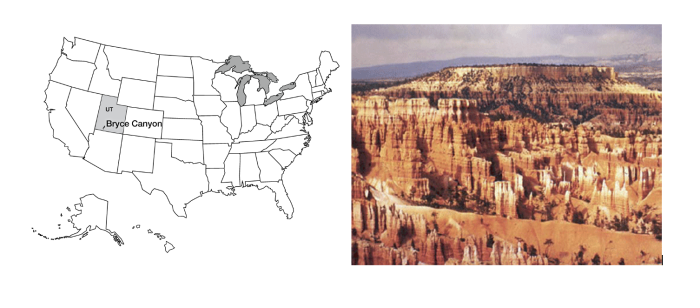
Credit: R. B. Alley © Penn State is licensed under CC BY-NC-SA 4.0
Bryce Canyon is a fairyland. Pillars, spires, and minarets, seemingly fragile and toy-like when viewed from the rim, tower far above the hiker who descends into the “canyon,” which is really a bowl carved out of the edge of a plateau. The morning sun, bouncing off the pink and pastel walls, casts a rosy glow on everything and everyone in the canyon. Gnarled trees cling to high slopes, their root structure exposed by erosion but somehow holding and nourishing the twisted branches. The old settler Ebenezer Bryce called the scenery of this tributary of the Paria River “a hell of a place to lose a cow,” but almost everyone who followed him has had a kinder assessment.
The main pink rocks of Bryce are a mixture of limestones, shales, and some coarser sandstones and conglomerates, deposited in a lake or a series of lakes, and together known as the Claron Formation or the Bryce Limestone. (Geologists studying regions have found it useful to give specific names to recognizable bodies of rock, with the names taken from geographic locations. Because the criterion for a new name is the ability to easily recognize a unit in the field, some really careful observers like to subdivide, and others like to lump, so there is often slight disagreement as to which name is most appropriate.) These Bryce rocks are from the early part of the Cenozoic, roughly 40 million years ago. The rocks record a generally wet time shortly following uplift of the land from a shallow seaway, and before continued uplift led to the high plateaus of today, and climate change dried the surroundings to the dry climate now at Bryce.
Some of this story is told in the rocks of Bryce. The rest is told nearby. Northeast of Bryce in central Utah, the rocks record the gradual transition from undersea to terrestrial. The growth and erosion of mountains to the west are marked by the appearance and then disappearance of coarse braided-stream deposits. These were replaced by slower streams, then by lakes, then another pulse of river sediments, and then the great Green River lakes that spread from Bryce to Wyoming and that record a wet, warm time in the west.
Geologists love to tell stories like this one. The seas came in, the seas went out, the mountains rose, the mountains were eroded. Such stories are useful, because they often include chapters such as “The oil formed here, and migrated there, and was trapped in those rocks, and we can drill into it this way and get rich.” Such stories tell us much about the stability of the Earth’s climate. And the stories are interesting to many people. But how do you read such stories, and gain confidence in them? One way to find out is to major in Geosciences and spend the next three years learning to do so professionally—in case you’re interested, talk to us! But if you’re really excited about the great career prospects in your current major of theatre or philosophy, at least read over the next few sections and you’ll get a brief sketch of geological techniques and what they tell us.
We saw at the Badlands that weather attacks and breaks down rocks, and we saw at the Tetons, in Canyonlands, and elsewhere that the loose pieces are transported. The processes of weathering and erosion produce new minerals from old, produce small pieces from big ones, produce dissolved salts, and move these around on the surface of the Earth. Eventually, these materials end up somewhere. The pieces derived from older rocks we call sediment. Sediment may be deposited on the bottom of a sea, or on the flood plain of a river, or at the end of a glacier. Sediment may stay for a while and then be moved on. If it stays for too long, it may be hardened.
There is no magic in making rock from sediment, nor is there an abrupt line separating the two. Many processes slowly transform loose pieces into pieces stuck together. If you don’t believe that loose pieces get stuck together, go to an old house and try to remove some piece of plumbing without using a really big wrench, or try to get pieces off an old bicycle without a big wrench. If you don’t have the time, trust us—people make big wrenches for a good reason! Nature does rust and otherwise bond things together in many cases.
The weight of additional material deposited on top of a sediment layer will squeeze it, forcing grains together and pushing water out. The resulting material is harder than what was there before. Continued squeezing and heating as sediment is buried (remember that the Mississippi delta is miles thick) produce rock from this sediment, and eventually may change these sedimentary rocks to metamorphic rocks. The clays in sediment change into different clays and then into other things as the cooking proceeds (just as flour and water and yeast make cookies in the oven), and as the crystals of the new minerals grow, they tend to wrap around each other and get “woven” together so they are hard to separate.
Groundwater circulating through sediments will dissolve minerals in some places and precipitate them in others, in response to subtle changes in temperature, pressure, or chemistry. We saw that there is dissolved rock in Spring Creek water, and in all other waters. If you have “hard” water, of the sort that causes people to buy water softeners, that means the water has a lot of dissolved rock and especially dissolved limestone. The white deposit that builds up on drinking glasses in houses with hard water is not soap scum but rock, very similar to stalactites in a cave. A lot of the sticking-together of plumbing pieces is linked to minerals precipitated from hard water. What happens in your house can happen in nature, where the precipitate serves as a cement that binds particles together. This cementation, together with the compaction from squeezing and the recrystallization from heating and changing clays, slowly turn loose sediment to sedimentary rock. Sometimes, rocks are made entirely of hard-water deposits—stalactites are an example, but so are the salt deposits left in the bottom of Death Valley when the water that runs down from the peaks quickly evaporates. Rocks made entirely of precipitate are also called sedimentary rocks.
Classification of Sedimentary Rocks
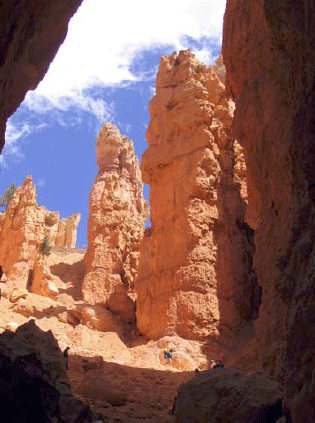
Our classification of sedimentary rocks is a bit of a hodge-podge. We first consider whether a rock is clastic (made from pieces or clasts of older rocks) or chemically precipitated (deposited from chemicals dissolved in water). This subdivision is not always satisfactory—a sea shell is a chemical precipitate because the animal pulled the material in its shell from the water, but a limestone made up of sea shells might be called clastic because the sea shells are chunks. Usually, people consider limestones and evaporites (rocks left by evaporation of water containing salts) to be chemical precipitates, and all others to be clastics.
Clastics are classified based primarily on grain size. The very smallest particles of clay make claystone or shale. Slightly coarser pieces are silt and make siltstone. Coarser still is sand, which makes sandstone. Going to still-bigger clasts, cobbles and boulders produce cobblestone and boulder-stone, but we also call both of these conglomerate.
Reading Sedimentary Rocks
We learn about the past through sediment. Archaeologists dig up the garbage dumps and houses of past peoples to learn how they lived. Historians root through the intellectual sediment of people to learn what they have done. Sedimentary rocks, in the same way, tell the history of the surface of the Earth.
A typical sedimentary rock contains all sorts of clues as to how it came to be. The clast size or grain size is a measure of the energy of transport—tiny clay particles will not settle out of a swift mountain stream, so a fine-grained deposit indicates slow or no currents. Grain shape tells more—an angular clast has not been transported far in water or wind, because during transport sharp corners are knocked off and the clast becomes rounded. Sorting also tells something—wind and water sort sediments by size, but landslides and glacier ice do not, so the sand grains on a beach are all about the same size, but a landslide leaves a deposit that ranges from miniscule clay-sized particles up to house-sized boulders and houses.
Composition provides clues—olivine is a mineral that is changed rapidly by chemical weathering and occurs primarily in low-silica igneous rocks such as sea-floor basalts, so if you find olivine grains in a sandstone, you know both that the sand was derived from such rocks, and that the sand was not transported very far in a wet environment because the olivine was not broken down. Even surface textures have information—the striations and polish of a glacier-transported rock look very different from the sand-blasted appearance of a quartz grain in a sand dune.
The sizes and shapes of deposits give further information. There are several ways to tell which way a current of wind or water was moving when it deposited a particular rock. For example, with sand dunes, the wind carries sand up a gradual slope and then dumps the sand over the top where it avalanches down and forms a steeper slope. When we find the gentle and the steeper slope in the rock, we can tell which way the wind was blowing. Sand ripples and bars deposited by flowing water have similar indicators. A sand body deposited by a stream often is long and skinny in the direction that the stream was flowing. A “fossil” sandy beach may be long and skinny like a stream deposit, but the current directions caused by waves will be pointing more-or-less across a beach but along a stream, so there is not much danger of confusing one type of deposit for another.
The list of indicators is very long. When mud dries out, it cracks to form mud cracks. Such features are easily recognized in rocks, and indicate occasional drying. Raindrops that spatter down on rocks leave little pock marks that are readily recognized if they are turned to stone and preserved.
Added to this, we have the advantage of fossils. Tree trunks in growth position indicate a non-desert deposit on land—trees are replaced by cactus in desert environments, and by seaweed underwater. Coral skeletons indicate a reef in the ocean.
With such a wealth of information, we certainly should be able to read much of the story of the past. All that is required is that: 1) we study the rocks carefully; 2) we know what sorts of sediments are produced in what sorts of environments today; and 3) we make the common-sense assumption of “uniformitarianism”, that the present is the key to the past.
Suppose that you go out today and observe that streams flow downhill and carry rock and mud from the hills to the sea. You dig around in a lot of different streams, and find that they have sorted sedimentary beds, occasional fish fossils, current-direction indicators pointing more-or-less the same way in many different sand bars, sand bars of certain shapes and sizes, etc. You talk to a lot of people, and read history books, and learn that streams have been flowing downhill and carrying rock and mud from the hills to the sea for a long time. You find a place where earlier people had diverted a stream into a canal, dig up the old stream bed, and find that it looks just like modern stream beds. You find still older deposits that look exactly like modern stream beds, and you find deposits in which the sand has been cemented by hard-water deposits to make sandstone, but everything else looks just like modern stream beds.
The reasonable person would say that these “fossil” cemented-to-stone stream beds are indeed old stream beds. Of course, we cannot prove that they are. Perhaps space aliens made the world the year before you were born in such a way that it looks like there were old streams, and the aliens invented all the history books and fake memories of old people. Calvin (of the Calvin and Hobbes comic strip) once told Susie that their class was having a substitute teacher because “our REAL teacher rocketed back to Saturn to report to her superiors. They’re trying to subvert us little kids with subliminal messages in our textbooks, telling us to turn in our parents when the Saturnians attack. Earth will be rendered helpless! I’m too smart for ‘em, though! I don’t read my assignments!” (To which Susie replied, “I think one of us has been eating too much paste in art class.”) Maybe Calvin is right. And maybe the Geology-of-National-Parks professors are Saturnian aliens, too! The textbook author, Dr. Alley, has really strange-looking hair where it hasn’t fallen out, and acts a bit peculiarly, you know.
However, despite his occasional interest in the topic, Calvin had not quite mastered geologic thought. Geologists take the common-sense approach: if it looks like a duck, and walks like a duck, and quacks like a duck, is genetically identical to type specimens of ducks, has a bone structure as observed in x-ray examination that matches known duck bone structure, mates with other ducks and produces duck offspring, etc., we call it a duck. If it looks like a stream deposit in size, shape, arrangement, location, grain size, sedimentary structures, fossils, etc., we call it a stream deposit. We learn from the present—what do streams do, what do they make, where do they occur—and then we use that knowledge as the key to interpreting the past.
Learning from the present is not a casual undertaking. By working hard in one or two advanced courses, a really adept student can learn to distinguish most of the main deposits—streams versus lakes versus beaches, for example. Many geologists spend their whole lives really learning what stream deposits look like, how they form, etc., while other people are spending their lives working on beaches, or lakes, or glaciers.
When lots of these experts agree that the limestones of Bryce and surroundings were deposited in a shallow lake and adjacent streams and mud flats, you should know that the rock type (limestone, but with differences in chemistry and texture from limestones forming in oceans), the fossils (algae, fish fossils, alligator bones, bird tracks), the structures (mud cracks, raindrop imprints), etc., have been considered carefully in telling the story. We can’t rule out Calvin’s Saturnians, but a more down-to-earth explanation is more convincing.
Stratigraphy and Arches National Park
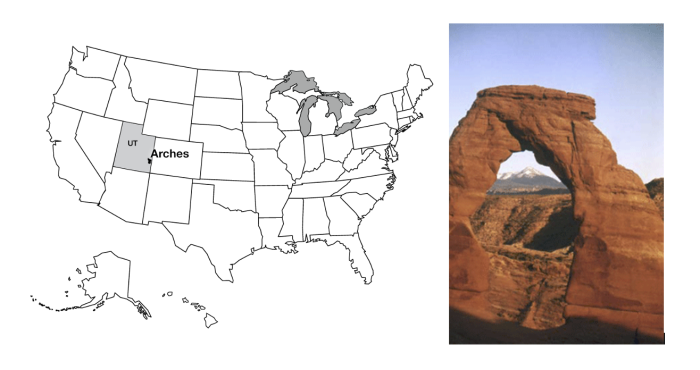
Credit: R. B. Alley © Penn State is licensed under CC BY-NC-SA 4.0
Arches National Park is just outside of Moab, Utah, almost within shouting distance of Canyonlands. Arches contains the largest concentration of natural stone arches in the world, with dozens of major arches, and numerous other holes and interesting rock features. The longest natural arch in the world is there, Landscape Arch, spanning about 300 feet (almost 100 meters). Several rockfalls have occurred from Landscape Arch since European settlers arrived, reducing the arch to a thickness of only 11 feet in one region. The trail under the arch has been closed; the Park Service knows that eventually more rocks, and the whole arch, will fall, and the rangers do not wish to be involved in extracting compacted humans from beneath the remnants of what used to be the world’s longest arch.
The arches are all eroded in sandstone, and especially the mid-Mesozoic (deposited during the time of dinosaurs) Entrada Sandstone, which includes both marine and wind-blown sands. Arch formation started with deposition of thick beds of salt in the Arches area. Sediments including the Entrada sands were deposited on top of the salt, and cemented by hard-water deposits to make sandstone. When the weight of those sediments became large enough, the salt began to flow, squeezed from places where thicker sediments caused higher pressure on the salt, to places where thinner sediments gave lower pressure, like ketchup in a fast-food packet squeezed from one place to another. However, the foil wrapping of a fast-food packet is fairly flexible, but the Entrada sandstone was not, so as the salt moved, the tough sandstone broke. The most common joints formed by this motion are parallel, nearly vertically oriented, and a few yards (or meters) apart. Weathering processes attacked the rocks along these joints, which were slowly widened to leave vertical slabs of rock called fins.
Some weathering and erosion processes are more effective near the ground than high up. For example, you will see huge steel bolts sunk into the rock of some road cuts just above the highway to keep the weight of the rock above from popping slabs of rock loose that might blast into the road and kill people; such rock-bursts also occur in quarries. When such slabs of rock fall, they often leave a curved or arch-like top, because it is easier to break off a curve than a square-cornered piece. This process is among those contributing to arch formation, breaking through the fins to make the beautiful stone arches.
Stratigraphy
The text above says that the Entrada Sandstone is from near the middle of a time we call the Mesozoic, an Era of geologic history, and for Bryce, our text told you that Bryce Limestone is from early in the Cenozoic Era of geologic time. You have not been asked to learn these terms yet (but you will be, so might as well lodge them in your brain now). The Mesozoic is older than the Cenozoic, so the Entrada is older than the Bryce. How do we tell which layers are older or younger?
Putting rocks in order is an enjoyable puzzle, requiring the sort of logic used in sudoku or in crossword puzzles. You rely on a few general principles that really boil down to common sense, plus a lot of puzzling and looking and thinking. Start with “what’s on top”? The layer of mud that settles out of floodwaters is deposited on top of the mud and grass and linoleum and grand pianos of the flood plain. Naturally, the mud from the flood of the next year is deposited on top of the mud from this year (nature doesn’t dust the grand piano). In ordinary sedimentary rocks, the youngest ones are on top and the oldest on the bottom. We call this the Principle of Superposition.
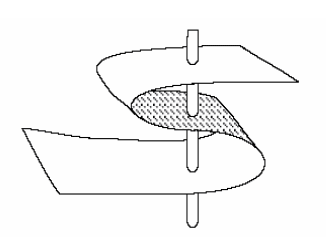
Note that this applies to ordinary rocks. There are cases in which rocks are turned upside down. Take a sheet of paper on your desk, put fingers on opposite sides and squeeze your fingers and the ends of the piece of paper towards each other (see the figure on the left). The paper will buckle into a fold. If you get your fingers together, the fold may “fall over”. A vertical hole through your paper would now go through the top of the page and out the bottom, but then through the bottom of the page and out the top, before finally going through the top and then the bottom—going from top to bottom, the paper is right-side up, then upside-down, then right-side up (look at the figure again).
Fortunately, there are many “up” indicators in rocks that tell you which way was up when the rock was formed. Animal tracks and raindrop imprints are made down into mud, not up. If you find a track pressed up into the roof of a cave, it is reasonable to suppose that the track originally went down but then has been turned over, so it is now upside-down. Mud cracks narrow and disappear at the bottom, not the top. Curved clam shells are usually flipped by currents into the stable, hollow-side-down configuration rather than the rocking, hollow-side-up configuration. Bubbles in lava flows rise to the top where they are trapped just beneath the quick-cooled upper surface; the bubbles do not sink down to the bottom. (You will meet some of this in the second V-Trip, and in the Rockin’ Review of this chapter, and in Exercise 4.) Hence, you can learn whether the rocks have been turned upside-down or not.
In clastic sedimentary rocks, the clasts must be older than the rock is. So a conglomerate containing pieces of granite and of other things tells of formation of a granite from melted older rock, followed by physical erosion to break the granite into pieces, followed by transport to mix the granite pieces with chunks of other rocks, followed by deposition of the chunks and hard-water cementation to make the conglomerate rock. A conglomerate containing pieces of sandstone tells of two cycles—make the sand from older rocks (perhaps from breakdown of a granite by chemical weathering), followed by transport of the sand to a beach, followed by cementation of the sand with hard-water deposits to make sandstone, followed by physical weathering of the sandstone to make sandstone chunks, followed by transport of the chunks and mixing with others and deposition and cementation to make the conglomerate. If a fault has split a granite clast in a conglomerate, and moved one side relative to the other so that the pieces no longer match, the fault must be younger than the conglomerate—something must exist before you can break it. If a layer of sandstone is standing up on edge, then it must have been deposited, hardened, and then tilted—because of mass-movement processes, layers are nearly horizontal when deposited (not exactly, but pretty close); if you tip a mud layer up on end before it has hardened, it spreads into a new, nearly horizontal layer.
Below is a photograph of an outcrop near I-70 in the near-desert conditions of central Utah (left), and a sketch of the outcrop (right). The rocks at the bottom were deposited on a sea coast—they contain marine fossils and other markers of the sea, and are mostly sandstone and shale. But they are standing on edge and truncated at the top. Developed on the top of them is a soil, and on top of that are lake deposits with flamingo bones, fish fossils and alligator bones.
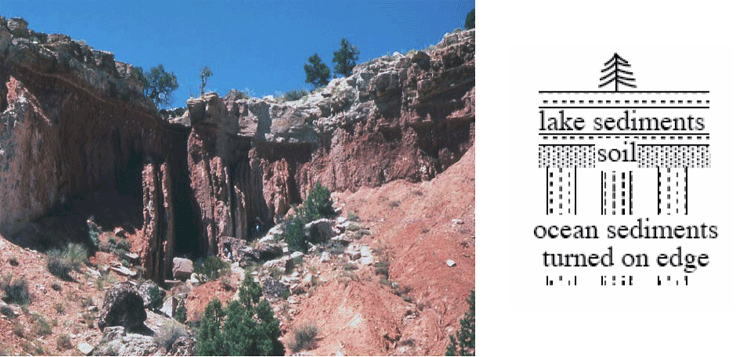
Credit: R. B. Alley © Penn State is licensed under CC BY-NC-SA 4.0
The story of this outcrop includes:
-
Some history to produce sand and mud and deliver them to the sea, where they were deposited and then hardened;
-
A mountain-building episode to turn the rocks up on edge;
-
Erosion to truncate the rocks, together with weathering to create the soil;
-
Growth of a lake, with sediment accumulation in the lake;
-
Drying or draining of the lake; and
-
Erosion to reveal a cross-section of the deposits.
You can postulate many other things—Dr. Alley is just lying about the rocks; or, the space aliens put the rocks there; or, a giant tornado blew the rocks there one afternoon; or…. We humans are very inventive, and can always come up with a new idea. But when you follow out the implications of these other stories, some fundamental problem always comes up, whereas the story of the rocks being deposited and hardened and tipped on end and eroded and so on works just fine, and makes predictions that are borne out over and over. Hence, the “geological” or “scientific” interpretation is the sensible one.
Notice that the erosion surfaces [events iii and vi in the list above] represent time gaps in the sedimentary sequence; the rocks at this site do not have a record of the environment during the time erosion was occurring—you have to go to where rocks were being deposited to learn that. A time gap in a sedimentary sequence, whether from actual erosion or just lack of deposition, is called an “unconformity”. Most of the land experiences erosion most of the time—the mud in the Mississippi is eroded from the lands upstream, and most of us most of the time do not have to worry about mud being deposited on our grand pianos or carpets. But, sediments are deposited on land, and sediments are deposited almost everywhere almost all the time under the sea, allowing a fairly complete story to be told.
Fossils and Relative Time: The Law of Faunal Succession
The material above explains how geologists can put rocks in order. The job may be quite difficult, because some outcrops are covered by soil, water, or other rocks, because offsets on faults may be so large that rocks on opposite sides can’t be matched back up easily, etc. But the job can be done.
When this job is done, a remarkable result emerges. Many rocks contain fossils, and different rocks contain different fossils. Arranging the rocks in order reveals that the fossils also are arranged in order. Rocks of similar age from similar environments have similar fossils; the more different the ages of the rocks (the farther apart they are in our ordered pile), the more different the fossils appear. The younger fossils have more in common with things living today than do the older ones. This observation, that fossils succeed one another in a definite and recognizable order, is called the Law of Faunal Succession. “Law” here is not something passed in Congress; a scientific “law” such as this one successfully summarizes an immense number of different observations, and works very well in explaining and predicting many different things in many places and times.
The Law of Faunal Succession was developed in England by a 17th century canal engineer/geologist named William Smith. He faced practical problems; digging in some rocks is easier than in others, some rocks hold canal water better than others, etc. If he crossed a river or a region with no rocks showing, and then found a few rocks, he wanted to know whether they were the ones he wanted, or whether the ones he wanted were up or down in the pile. Sometimes, a few fossils would be evident in a streambed, or even would be in use as weights for balances to weigh cheese of the local farmers, and he found that the fossils made his job easier by providing shortcuts for putting things in order.
Much later, faunal succession figured in the debates over evolution. But you should remember that the Law of Faunal Succession is like so much good science—a practical idea that gives useful results and helps humans do things successfully.
The Geologic Time Scale
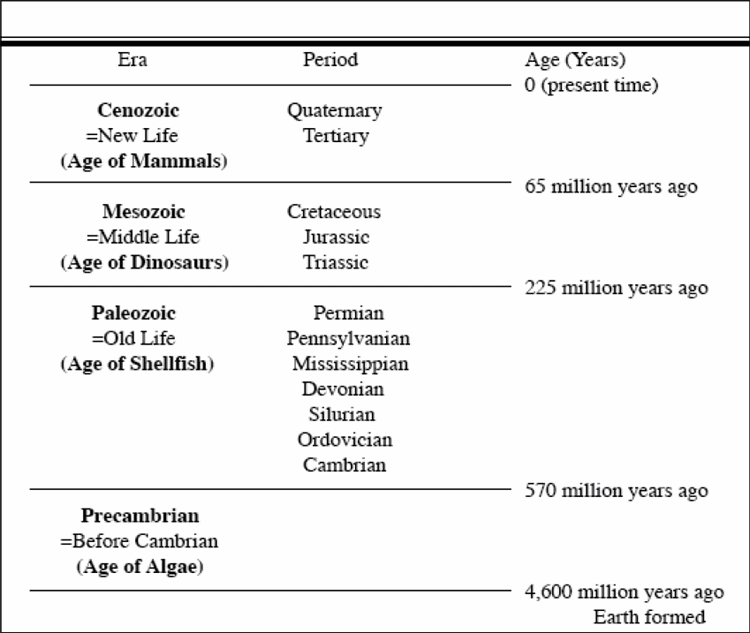
Geologists learned to put rocks and fossils in order long before calendar-year ages could be assigned accurately (how many years old is that?). Lacking accurate year counts, the early geologists agreed on a “shorthand” for describing ages. Time is divided into big chunks, called “eras,” which are themselves divided into smaller chunks, or “periods,” and on into still smaller chunks. The big chunks (which you would be wise to know) are, from youngest to oldest, the Cenozoic (= new life), the Mesozoic (= middle life) and the Paleozoic (= old life) (see the table on the following page).
The oldest period in the Paleozoic is called the Cambrian, and the rocks older than it are called the Precambrian. As the Precambrian includes most of the history of the Earth, more and more workers are using “-zoic” terms for pieces of it (see the Enrichment for Unit 9). The periods are mostly named for places where the rocks are well-developed, such as the Cambrian for Cambria (also known as Wales), Devonian for Devonshire in southwestern England, and the Pennsylvanian for Pennsylvania (Europeans usually lump the Mississippian and Pennsylvanian and call that lump the Carboniferous, but we have such wonderful deposits of their Carboniferous that we divide them to allow better time resolution, and to use our names). The youngest two periods, the Tertiary (third) and Quaternary (fourth), were named in an old scheme that also included primary and secondary; history dies hard in geology.
Life appeared early in the Precambrian, and multicelled organisms were present in the Precambrian. The Cambrian began with a great diversification of organisms with shells. Older fossils are rare because soft body parts usually are not fossilized; when shells appeared, they accumulated to make limestone layers, so fossils “suddenly” (over a few million years) became common. The Paleozoic and the Mesozoic ended with mass extinctions that probably killed the great majority of organisms on Earth (we’ll return to this soon). The mass extinction at the end of the Mesozoic was caused by a meteorite impact at the end of the Paleozoic that is not fully explained, although radical changes in ocean circulation in response to global warming and massive volcanism that produced a widespread lack of oxygen in the ocean probably were involved.
GeoMations
The Cake
Transcript: It’s the weekend, and you’re baking a cake for the game for the big game. And so you put down a layer of cake like this. And then it’s gotta be for the Penn State game. So then you’re going to put in a little blue icing, so it’s more enjoyable. And you’re going to make another layer cake on top of that, still sitting there. Boy, you’re a good baker. It’s really very impressive.
And we’ll put some more Penn State blue icing in the middle. And then you put down one more layer of cake to make the top of the thing. And wow, this is getting to be fairly serious when all is said and done. And then you’re going to ice the top of that, and wow, isn’t that beautiful.
And then you want to put some candles on. It’s going to be Wisconsin game, and Wisconsin’s going to get burned. So you better put on some Wisconsin red candles, and they have a little wick sitting out the top of them like that. And then you’re carrying the cake across the floor and your big dog comes up and takes a gimungous bite out of your cake, which doesn’t necessarily make you entirely happy. And so now your cake is going to look something more like this with this big hole out of it. And the hole goes all the way down, something like that.
Oh dear, what a mess the dog made out of the cake. And you’re really very, very unhappy about what your dog did to it because you were carrying the cake while this happened, and you happen to know that if you’re carrying the cake while it happens that you may lose your grip, and the cake turns upside-down, which is now a real mess, and the candles gets scrunched, and so they’re no longer sticking down the way they’re supposed to be. They’re actually sort of sticking off to the side the way they get bent over.
Now, if you were to see this, if you were to find this cake on the floor, you would have absolutely no trouble telling what happened, and the sequence of events in which they happened. In the same way, a geologist faced with something such as a rock viewed edge on that has some mud cracks in it like this, there’s a crack, says oh, this rock is right-side up, it has not been turned over because we know that when mud cracks, that the cracks go down in the rock, not up.
In the same sense, if the geologist was faced with some sort of a footprint, and let’s make a dinosaur footprint here, if you would like to. Do, de-do, de-do. Here’s the big footprint. OK. And the footprint is stuck down in the rock, something like that. And so you can see this is how it might have happened somehow. And that’s not the world’s finest footprint drawing, but you get the idea what we’re trying to do. That has been shoved down into a rock so there’s a big hole here where the footprint was made.
If you were to happen to find that footprint, and you’re going to have to find that footprint as being upside-down, as we can make it very easily with the foot vertically, you wouldn’t know that. And so geologists do that. They can put things in order in the same way you that could look a that squished cake and put it in order.
Optional Enrichment Article
The Cenozoic, Mesozoic, and Paleozoic Eras are lumped together into the Phanerozoic Eon; “Phanerozoic” is from Greek roots meaning that life showed itself. The Phanerozoic started with the fairly sudden (over a few million years) appearance of common shells, which greatly “improved” the fossil record. You have to look mighty hard to find the remains of a jellyfish in a rock, but with shells, the remains are the rock. Going back in time before the Phanerozoic are the Proterozoic (earlier life), the Archean or Archeozoic (beginning life; different people prefer Archean or Archeozoic), and the Hadean (like Hades; hellish).
The Hadean, from about 4.55 or 4.6 billion years to about 3.8 billion years ago, probably experienced such huge meteorite impacts that they vaporized the whole ocean and some rocks as well. Life would have been hard-pressed to survive such catastrophes.
Life was present by the beginning of the Archean, at about 3.8 billion years ago. The central regions of the continents had formed by the end of the Archean, about 2.5 billion years ago. Oxygen remained scarce or absent in atmosphere and ocean, and carbon dioxide helped keep the world warm under the gaze of a young sun that was not as bright as today.
In the Proterozoic, oxygen from cyanobacteria and other microbes “rusted” the oceans. Iron rusts with oxygen, but in the oxygen-poor world of the Archean, iron dissolved and washed to the ocean rather than rusting. As oxygen was released by photosynthesis, the iron was rusted and fell to the bottom to form the great banded iron formations that we mine today in Minnesota, Australia and elsewhere. Oxygen then increased in the atmosphere. First a poison to many living things because it is so highly chemically reactive, oxygen proved invaluable as life figured out how to use the “new” chemical, allowing development of larger organisms. Oxygen also shielded all organisms from damaging ultraviolet rays by giving rise to protective ozone in the stratosphere. As oxygen rose in the atmosphere and combined with gases there that were stable without oxygen but unstable with oxygen, those gases were removed. Some of those were strong greenhouse gases, and removal of them under the not-yet-modern-brightness sun allowed “snowball Earth” events that very nearly froze the planet.
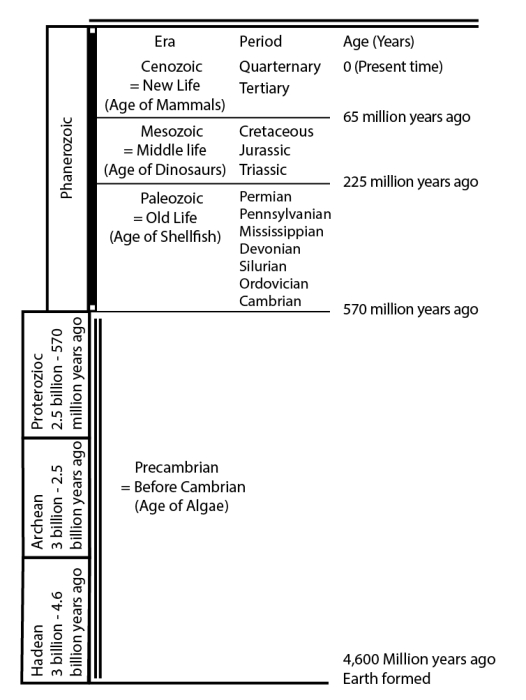
Key Takeaways for Stratigraphy and the Sedimentary Record
Nice Bryce: Stories in Sediment
- Weathering makes small pieces and salts that are transported and deposited as sediment
- Sediment is slowly changed to sedimentary rock.
- Hard-water deposits cement grains together;
- Squeezing compacts grains;
- Recrystallization as new minerals grow creates interlocking grains.
Classy classification
- Clasts make clastic rocks (sandstone and conglomerate); dissolved salts make precipitates (rock salt, Death Valley borax).
- Limestone is both–precipitated as shells, which are clasts.
- Subclassify clastic rocks by size:
- Clay (tiny) makes claystone, also called shale;
- Silt (small) makes siltstone
- Sand makes sandstone;
- Gravels make conglomerate.
Environment is Evident
- Can tell environment in which sediment or sedimentary rock was deposited:
- Sand dunes, lizard tracks? Desert
- Quiet-water muds, fish fossils? Lake or tidal flats
- Corals and shells? Coastal Reef
May I Take Your Order?
- Something must exist before it can be moved or cut; clastic rocks are younger than the clasts, and faults younger than faulted rocks.
- Layers initially nearly horizontal
- Layers on top are younger than those below (Principle of Superposition).
- After hardening, layers may be stood up or turned over, but many “up” indicators tell us this happened.
Getting Into “Up” Indicators
- Mud cracks, footprints, raindrop imprints go down into mud;
- Tops of slightly slanting sand-dune layers are eroded by wind;
- Shells on beach are flipped into stable hollow-side-down position;
- Bubbles rise toward tops of lava flows.
Nothing Succeeds Like Succession
- Can put rocks in order.
- Puts fossils in order–“Law” of Faunal Succession;
- Gives geologic time scale:
- Cenozoic=New Life, Age of Mammals
- Mesozoic=Middle Life, Age of Dinosaurs
- Paleozoic=Old Life, Age of Shellfish
- Precambrian=really old, Age of Algae

